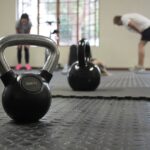Grip strength is one of the most important factors when it comes to overall fitness, health, and longevity. Whether you’re lifting weights, playing sports, or simply performing daily tasks, your grip strength plays a key role in how effectively you function. But what if you’re unknowingly sabotaging your grip strength progress? Many people make simple mistakes during their grip strength exercises that can hinder their results or even cause injury. We’ll go over common grip strength exercises you might be doing wrong and show you how to correct them to maximize your gains.
1. The Deadlift Grip Mistake Using an Overhand Grip Only
Common Mistake
The overhand (pronated) grip is a popular choice when performing deadlifts. However, it can lead to grip failure as the barbell becomes slippery, especially as you lift heavier weights.
Fix It
Switch to a mixed grip (one hand overhand, one hand underhand) for deadlifts. This creates more stability and prevents the barbell from rolling out of your hands. If you prefer to stick to the overhand grip, consider using lifting straps as a training aid to prevent premature grip failure.
Why It Matters
A strong, secure grip during deadlifts is essential for preventing injuries and engaging your muscles properly. The mixed grip also targets the forearm muscles differently, improving overall grip strength.
2. The Pull-Up Grip Mistake Not Engaging Your Hands Enough
Common Mistake
When doing pull-ups or chin-ups, many people focus so much on their arms and shoulders that they forget to fully engage their hands. A weak grip often leads to poor form and premature muscle fatigue.
Fix It
Make sure to actively squeeze the bar throughout the movement. Imagine you’re trying to crush the bar with your hands as you pull yourself up. This engages your forearms, biceps, and upper body in a more controlled way, allowing for better muscle recruitment.
Why It Matters
Squeezing the bar more tightly will recruit more muscles and significantly improve your grip strength, allowing you to perform more reps and see better results over time.
3. The Farmer’s Carry Mistake Not Keeping Your Wrists Neutral
Common Mistake
During the farmer’s carry, many people allow their wrists to flex too much, either bending backward or forward as they carry heavy weights. This can lead to wrist strain and reduces the effectiveness of the exercise.
Fix It
Make sure to keep your wrists neutral (straight) while holding the weights. This will activate your forearms more effectively and prevent unnecessary stress on your wrist joints. If you’re lifting very heavy, try wrapping your thumbs around the handles for added grip stability.
Why It Matters
Maintaining neutral wrists helps distribute the load evenly, reducing the risk of injury while engaging the forearm muscles more efficiently, improving grip strength over time.
4. The Wrist Curl Mistake Using Too Much Weight
Common Mistake
Wrist curls are great for strengthening your forearms, but many people make the mistake of using excessive weight, which can lead to improper form and potential injury. Using too much weight reduces the range of motion and makes it harder to maintain control.
Fix It
Instead of focusing on heavy weights, start with a lighter load that allows for a full range of motion. Gradually increase weight as your forearm strength improves. Keep your wrist movements slow and controlled to ensure maximum activation of the forearm muscles.
Why It Matters
Controlled wrist curls target the forearm muscles effectively and help prevent injury, making them more beneficial than attempting to lift too much weight too quickly.
5. The Hammer Curl Mistake Using Momentum Instead of a Steady Grip
Common Mistake
When performing hammer curls, many people swing their arms or use their body momentum to lift the weights, bypassing the work that should be done by your forearms and grip.
Fix It
Slow down the movement and use a controlled tempo. Focus on squeezing the weight tightly with your hands, especially at the top of the curl. Don’t use your lower back or legs to swing the weights up. If necessary, reduce the weight to maintain good form.
Why It Matters
Hammer curls are a great exercise to build grip strength, but swinging the weights or using momentum reduces muscle engagement and effectiveness. A controlled movement maximizes forearm activation, boosting your grip strength and overall muscle development.
6. The Plate Pinch Mistake Not Pinching Long Enough
Common Mistake
The plate pinch exercise involves pinching two weight plates together with your fingers and holding them for time. A common mistake is not holding the pinch for long enough to truly challenge the forearms.
Fix It
Increase your hold time and aim for longer durations with proper form. Start with shorter intervals (15-20 seconds) and gradually work up to holding the plates for 45 seconds to a minute. Focus on maintaining a firm pinch without allowing the plates to slip.
Why It Matters
Holding onto the weight for longer periods helps build endurance in your grip, and it specifically targets the muscles in your fingers, thumbs, and forearms essential areas for improving grip strength.
7. The Grip Strengthener Mistake Relying Too Much on Finger Grippers
Common Mistake
Finger grippers are a popular tool for building grip strength, but many people rely solely on them for their grip training. While finger grippers can be effective, they don’t train all of the muscles involved in a strong grip.
Fix It
Incorporate a variety of grip-strengthening exercises into your routine, such as deadlifts, pull-ups, and farmer’s carries. These compound movements engage more muscle groups, improving your grip strength from different angles.
Why It Matters
Focusing on a variety of exercises provides more comprehensive grip strength development and reduces the risk of imbalances. Using only finger grippers can lead to overtraining specific muscles and neglecting others, limiting overall progress.
Fix Your Grip Strength Mistakes for Maximum Results
Grip strength is crucial for overall fitness and everyday tasks. However, doing grip exercises incorrectly can slow your progress and lead to unnecessary injury. By correcting the common mistakes listed above and applying the proper techniques, you can maximize your grip strength potential.
Whether you’re lifting weights, doing pull-ups, or performing functional movements, the right form is essential for achieving the best results. Focus on form, consistency, and gradual progression to unlock your full grip strength potential and improve your overall physical health.


